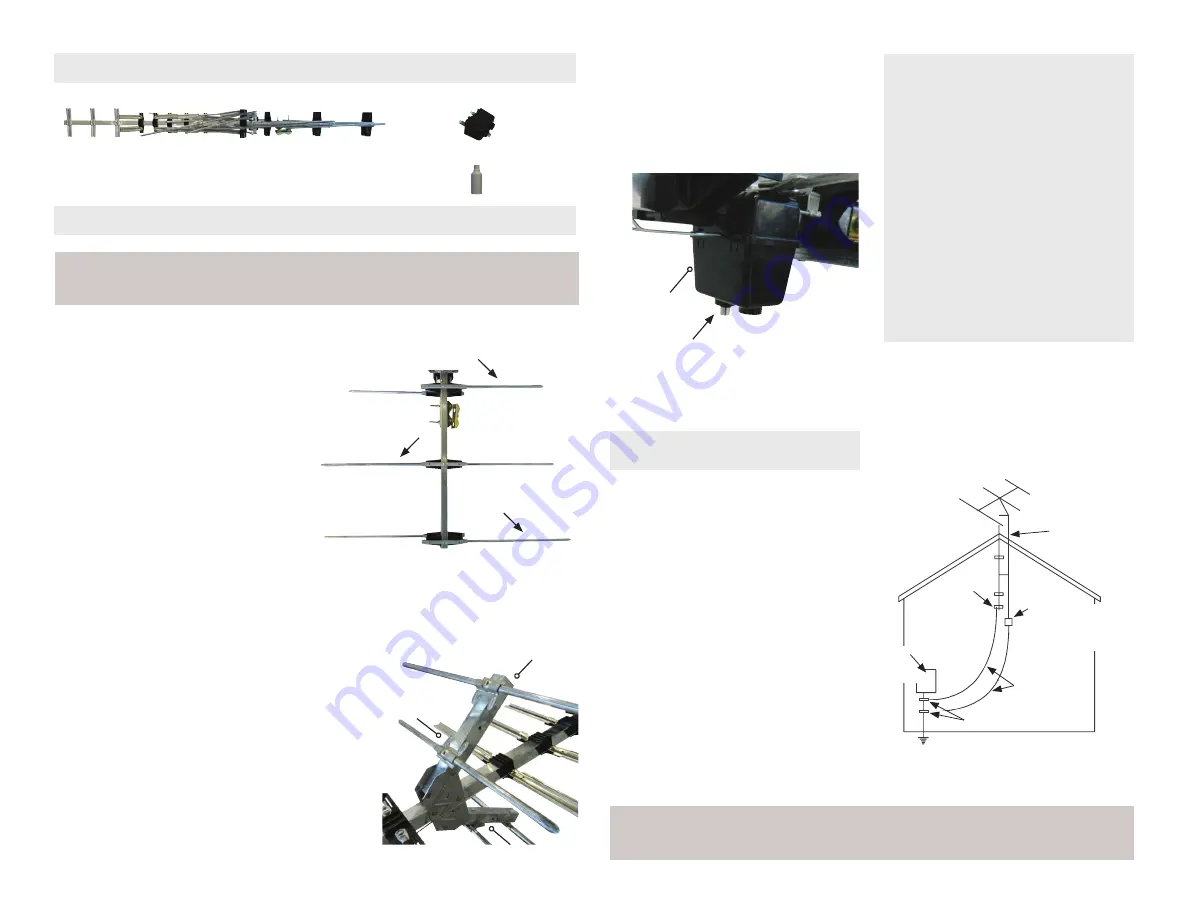
PARTS LIST
Antenna Assembly
Cartridge Housing
Rubber Weather Boot
ASSEMBLY
1)
Remove the antenna assembly
from the carton and compare
with parts list to ensure nothing
is missing and to become familiar
with the part names.
2)
Lay the antenna on the ground with
the cartridge housing receptacle
facing down and the long elements
pointing towards you. Starting
with the element closest to you,
unfold the first three elements per
Figure 1
in direction of arrows until
they lock into place in the black
plastic blocks. Unfold the rest of
the elements on this side of the
antenna to the lock position.
3)
Turn the antenna over so the
cartridge housing receptacle is now
facing up. Repeat step 2. Again lift
and rotate the elements that are
folded to the opposite side of the
boom just enough to slide over the
elements and boom.
4)
Unfold the reflector booms slowly
until they lock in place. Then unfold
the elements on the reflector
booms. See
Figure 2
.
ATTACHING ANTENNA TO MAST
Loosen nuts on the mast clamp. Slide
the antenna over the mast, pointing
the front of the antenna (small end)
towards stations and tighten mast
clamp securely using a crescent
wrench (not included).
ATTACHING THE COAX
Slide the rubber boot over the end of
the coaxial cable. Attach the coaxial
cable to the cartridge housing. Slide
the boot over the boot collar on the
housing. The coaxial downlead may
be secured to the mast with tape or
plastic wire tires. See
Figure 3
.
5)
Attach the housing cover so all 4
snaps are locked in place. Direction
of the housing does not matter.
See
Figure 3
.
1 Down
2 Up
&
Over,
Down
3 Up
&
Over,
Down
Reflector Boom
Reflector Boom
Element clip tip
pointing away
from main boom
Cartridge
Housing
Attach coaxial
cable with boot
1)
Mount the lightning arrestor or
75 ohm coaxial grounding block
as close as possible to where the
75 ohm coaxial cable downlead
enters the house. See
Figure 4
.
2)
The ground wires for both the
mast and the downlead should be
copper or aluminum wire, number
eight or larger. See
Figure 4
.
3)
The downlead wire from the
antenna to the lightning arrestor
and the mast ground wire should
be secured to the house with
stand-off insulators, spaced four
to six feet apart. See
Figure 4
.
NOTE:
In the case of a “ground up” antenna installation, it may not be necessary to ground the
mast if the mast extends four or more feet into the earth. Consult a TV serviceman for the proper
depth in your location.
LIGHTNING PROTECTION
FOR TV ANTENNA
&
SET
Antenna Lead
In Wire
Ground
Clamp
Electric
Service
Equipment
Antenna
Discharge Unit
(NEC Section 810-20)
Power Service Grounding
Electrode System
(NEC Art 250, Part H)
Ground
Clamps
Grounding Conductors
(NEC Section 810-21)
NEC - National Electrical Code
Example of antenna grounding as per
National Electrical Code, ANSI/NFPA 70
(May substitute a 75 ohm
Coax Grounding Block)
Figure 4
Example of antenna grounding as per
National Electrical Code, ANSI/NFPA 70
NEC – Nation Electrical Code
Antenna
Downlead Wire
Ground
Clamp
Electric
Service
Equipment
Antenna Discharge Unit
(NEC Section 810-20).
May substitute a 75 ohm
coax grounding block
Ground Clamp
Power Service Grounding Electrode
System (NEC Art 250, Part H)
Grounding
Conductors (NEC
Section 810-21)
Figure 1
Figure 2
Figure 3
NOTE:
To prevent damage in shipping, some of the elements are folded to the opposite side of
the boom. For maximum performance, you must unfold the elements correctly. Please follow the
steps below.



















